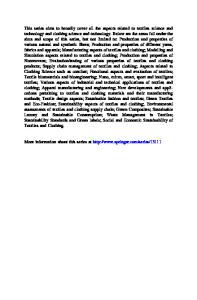Simulation Modeling of the Structure of Twisted Yarn with Embedded Electrically Conducting Fibers
- PDF / 1,837,986 Bytes
- 5 Pages / 594 x 792 pts Page_size
- 35 Downloads / 307 Views
Fibre Chemistry, Vol. 52, No. 2, July, 2020 (Russian Original No. 2, March-April, 2020)
MATHEMATICAL SIMULATION OF PROCESSES SIMULATION MODELING OF THE STRUCTURE OF TWISTED YARN WITH EMBEDDED ELECTRICALLY CONDUCTING FIBERS D. B. Ryklin and V. V. Davidyuk
UDC 677.072
The present article is devoted to simulation of the structure of yarn with embedded electrically conducting fibers. Migration of fibers into different sections of the yarn is taken into account in the simulation. The influence of the linear density and structure of yarn with embedded electrically conducting fibers on the average number of contacts that arise between the fibers in the simulated sections is determined. Through simulation it was possible to assess the degree to which twisting tends to increase the number of contacting electrically conducting fibers, a factor that, in turn, defines the stability of the electrical properties of blended yarn.
Wide-ranging technical re-engineering accompanied by installation of the latest production equipment produced by the world’s leaders in textile machine construction has been carried out at most spinning mills in the Republic of Belarus. The development of a wide range of different types of yarn and blended fibers for the manufacture of textile materials for special purposes represents one approach to increasing the efficiency with which already installed equipment is employed. It is precisely the development of special fabrics which represents the basic method of sustaining textile production in most countries of Western Europe. The modern range of fibers with special properties is quite broad. It includes high-strength, fire- and heatresistant, and conducting fibers as well as fibers with antibacterial, thermoregulating, and other properties. Electrically conducting fibers are used as special-purpose to solve one of two problems, either to create an antistatic effect or to shield against electromagnetic radiation. Bekinox fiber, manufactured by the firm of Bekaert (Belgium), is the most well-known and the most common type of fiber used to create antistatic fabrics. The fiber is in the form of segments of stainless steel wire and is generally produced as tape in pure form (Bekaert Bekinox VS) or in tape (Bekaert Bekinox LT) in which Bekinox fiber is mixed with polyamide fiber [1, 2]. The objective of developing a simulation model of the structure of twisted yarn in which conducting fiber is embedded was to determine an efficient composition of yarn that ensures the stability of its electrical properties. In the present case, the process of ensuring the stability of properties is understood the production of a structure of fiber in which there exists a continuous sequence of contacts of the conducting fibers from the first to the last contact in a given section along a segment of given length.
Vitebsk State University of Technology, Republic of Belarus; e-mail: [email protected]. Translated from Khimicheskie Volokna, No. 2, pp. 61–64, March–April, 2020.
0015-0541/20/5202-0129© 2020 Springer Science+
Data Loading...











